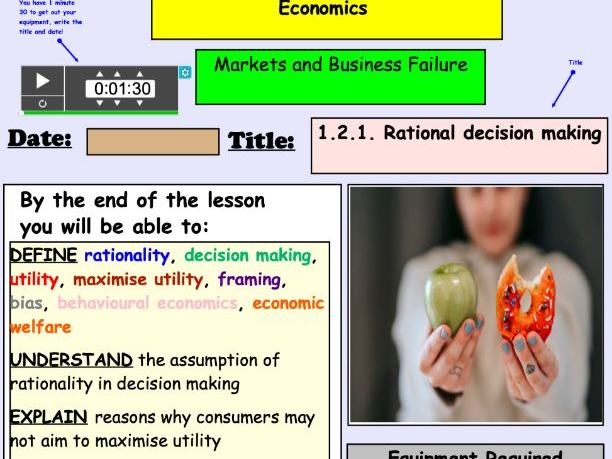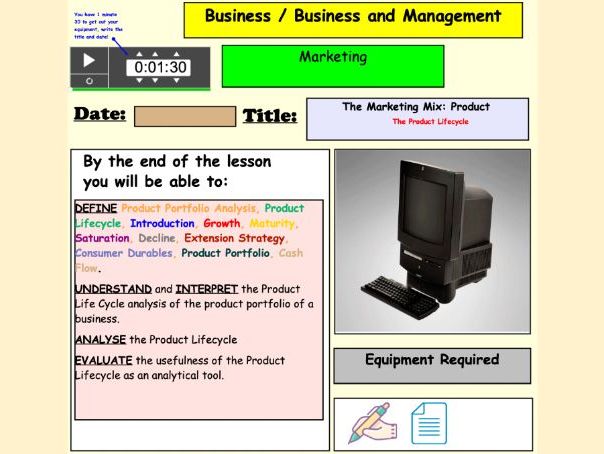83Uploads
9k+Views
5k+Downloads
All resources

Payback Period (PBP) Worksheet
A simple worksheet where students need to calculate the payback period of 4 investment options.
Answer key included

Finance Assembly Sixth Form
This PowerPoint contains 40 slides that informs sixth form students about managing their money effectively once they finish school or college regardless of whether they are entering employment, a university course or apprenticeship.
Included are:
Introductory information on number of students who don’t finish courses and apprenticeships and top 5 reasons why (number 2 being poor financial management)
Importance of budgeting
Overdrafts
Interest, EAR rate and APR rate
Credit cards
General advice
It took me 30 minutes to go through the presentation in assembly but can also be used in a lesson

Indirect Taxation WORKSHEET
A worksheet that tests understanding of directly and indirect taxation.
There are 4 activities in this worksheet:
A fill the blanks activity that tests students understanding of types of direct and indirect taxation and the correct terminology used depending on the tax being discussed
An activity where students need to calculate tax per unit, incidence on producers, consumers and government revenue
An activity where students need to explain why the incidence on the producer / consumer changes depending on the price elasticity of demand
An extension of activity 2 where students are given 4 additional diagrams where they need to complete additional calculations and label the incidence / tax revenue
3 multiple-choice questions on indirect taxation
Detailed answers of all* activities are provided in this worksheet
This activity took between 20 and 30 minutes for my students to complete

Average Rate of Return
Included in this lesson:
A detailed and colourful title slide, including all learning objectives for this topic
A recap starter activity on calculating the payback period (answers included)
An explanation slide as to what the lesson is about; providing an overview of the problems of relying solely on the payback period as a method of investment appraisal and why other methods are also needed
Explanation of what ARR is
A scenario showing how ARR is calculated
An evaluation of ARR
There are 22 slides in total and it took me around 30 minutes to go through the presentation.

Market Failure (Types of)
This lesson introduces the concept of market failure and explains what each of the key types of market failure are (externalities, under-provision of public goods and information assymmetry)
Included in this presentation is:
A colourful title slide with the key learning objectives
A ‘guess the question’ starter activity with answers
A step-by-step explanation as to what market failure is
Video showing an extreme example of externalities
Fill the blanks externality activity
Externalities sorting activity with answers
Positive externality activity
Information gap activity
Detailed and colourful notes throughout
This presentation is 32 slides in length and took me one hour to go through

Market Structures and Competition
This lesson can be used either to teach Business students about competition, market structures and how consumers can be affected by anti-competitive practices OR to teach Economics students about the different features of market structures and why competition / a lack of competition affects different stakeholders.
Included in this lesson:
A colourful and detailed title slide outlining the key learning objectives
An income elasticity of demand starter activity suitable for both Business and Economics students (calculation / explain / diagram question). A printable slide of the questions has been provided with a detailed answer key on next slide for peer marking.
A detailed and contextualised example of how a lack of competition affects different stakeholders (Epic Games legal battle with Apple over Fortnite)
Brainstorming activity on competition
A rank in order activity on types of competitive markets
Detailed notes on competition, monopolies, oligopolies, monopolistic competition, perfect competition, Game Theory, types of anti-competitive practices such as Cartels, OFT.
This presentation contains 37 slides and took me an hour to go through with my students.

Rational Decision Making
This resource is a 17 slide PowerPoint that explains the concept or rational decision making.
Included in the presentation:
A colourful and informative title slide that outlines the learning objectives
An engaging and interactive online ‘vortex’ starter activity. Students need to match which key term links with which of four topics. Activity is self marked and instructions are included
Explanations of how rational decision making is a principle of neo-classical economics
Contextualised examples of how customers don’t always act rationally (Nudge Theory, Third Decoy, Dopamine, FOMO)
Explanation as to why consumers may not act rationally
This resource took me 30 minutes to complete

Porter's Five Forces
This PowerPoint introduces the theory of Porter’s Five Forces
Contextualised examples included (including why Apple hasn’t entered the airline example)
Each force is explained individually
Notes provided throughout
PowerPoint is colourful and engaging

Business Location
A 20 slide PowerPoint presentation outlining the qualitative and quantitative factors businesses consider when choosing a business location.
The PowerPoint is colouful, informative and includes a ‘Tenable’ game show PowerPoint where students have to identify 10 common reasons why businesses fail

Marketing Mix - Price
This resource is a 58 slide PowerPoint presentation that gives a comprehensive overview of pricing strategies. Included in this resource:
A colourful title page outlining the learning objectives
A fun catchphrase starter activity where students have to guess the name of a business / product from the pictures given [answers included]
A critical path analysis recap activity [answers included]
An introductory explanation of the importance of pricing products correctly
Detailed explanations with examples of market-based, competition-based and cost-based pricing strategies
Colourful examples provided throughout
Calculation activities [with answers] for the cost-based pricing strategies
Colourful gifs and animation are included throughout
This lesson took me just over an hour to go through with students.

Product Lifecycle
Included in this PowerPoint presentation;
A colourful title slide outlining the key learning objectives
A fun Catchphrase starter activity that my students adore!
An introductory slide explaining what the lesson is about
An introductory game where students have to recognise brands of drinks currently / previously owned by Coke (this activity links into product lifecycle)
A hyperlinked video about the rise and fall of Subway (10 mins in length)
Detailed and colourful notes on what the product lifecycle is and what happens at each stage
A simple class activity where students have to be creative and think about how to extend the product lifecycle for 4 random products (I get students to either stand up and explain their suggestions / draw them)
Colourful gifs and animations are included throughout to ensure full engagement from students
This lesson contains 38 slides and took me a full hour to complete with all the activities included

Market Share
This presentation includes:
A colourful title slide with learning objectives and clickable timer to give students a minute and a half to get down the title
Detailed notes providing explanations of markets, market growth, calculation of market share, how market share increases as well as the benefits of high market share
3 mini activities; 1 - Calculating market share, 2 - Which markets are growing and shrinking in size 3 - Which business is the market leader in 4 different industries
This lesson took me 30 minutes to go through with my students

Terms of Trade
This colourful and informative resource is fully comprehensive, and includes a number of tasks that test learning that do not require any marking from the teacher.
Included:
A detailed and colourful title screen, outlining the learning objectives and including an interactive timer and picture animations
A ‘guess the question’ starter activity with answers that tests understanding of earlier macroeconomic content
A quiz on UK imports and exports
Detailed explanation of ‘weighted indexes’ with questions and answer scheme included
Past exam question with mark scheme on terms of trade
Link to a video reviewing terms of trade and index numbers
Detailed explanations of factors affecting terms of trade and Prebisch-Singer hypothesis
8 mark question with mark scheme
Homework tasks, including a link to a Teams Quiz with 17 questions on terms of trade. Questions are self-marked when students respond
All resources took me 3 lessons to go through

Free, Mixed and Command Economies
The PowerPoint attached is an informative presentation that explains the difference between command, mixed and free market economies.
Contextualised exams provided throughout.
This presentation contains 18 slides and took me 30 minutes to go through

Franchises / Franchising
This PowerPoint is a 20 slide resource that containd the following:
A colourful title slide with lesson objectives and animations
An editable ‘guess the starter’ activity
Franchising logo activity
McDonalds information video
Notes
Additional activities
This presentation took me 45 minutes to go through with my students

Rational Decision Making (Economics)
17 slides in total, including a fun starter activity
This presentation took me 30 minutes to go through with my class

Sales Forecasting, Market Analysis Worksheet
This worksheet contains a range of sales forecasting and market analysis activities. All answers are included.
Included in this worksheet are activities on:
Market share
Interpreting bar charts
Scatter diagrams
Line of best fit
Extrapolation
Moving averages
Positive, negative or unrelated correlation

Change Management (Business)
This resource is a detailed, comprehensive PowerPoint (124 slides) on change management.
The resource is split into four separate lessons that breaks down the topic in manageable chunks.
The resource contains:
several starter activities
videos
animations
exam practice
detailed notes
Coliurful and engaging throughout.
This resource lasted a full week of lessons (3 hours) for me

Demand (SMART NOTEBOOK VERSION)
Please note that this is a SMART NOTEBOOK presentation and not a PowerPoint presentation

Revenue (Economics) - TR, MR, AR, PED
This 100 slide lesson details:
the meaning of total revenue, marginal revenue and average revenue
the relationship between marginal revenue and price elasticity of demand
the concept of price-taker and price-maker
the formula used to calculate each type of revenue
diagrams for TR, MR and AR depending on whether the firm is a price-taker or price-maker
Engaging activities are provided throughout (answers included)
Questions and answers are also provided
Resource is colourful and interactive with animations throughout
This lesson took me 4 hours to complete with my students




















